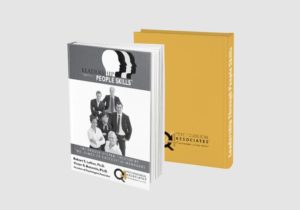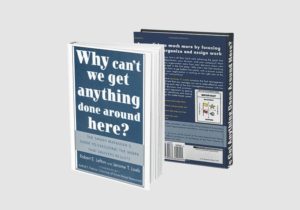Dimensional Selling
The Dimensional Selling book was the first book on sales to deal with the psychology of selling. Written by industrial/organizational psychologists, Dr. Robert Lefton and Dr. Vic Buzzotta, it teaches practical tips for more effective sales interactions.
This book on sales is written for both salespeople and sales managers. It explains how to get better sales results by enhancing your people skills so that you can sell different people differently. Dimensional Selling teaches how to size up customers, how to match their behavior to an effective sales strategy, and how to gain commitment. Build customer relationships your competitors can’t match! Thousands have benefited from the Dimensional Selling book and workshop. Check out the reviews.
Among the skills you will learn:
- How to gauge and spin up a prospect’s receptivity. Most salespeople do a subpar job of gauging receptivity. When a prospect is not receptive, your message goes in one ear and out the other.
- How to better understand and respond to customer needs. Most salespeople don’t ask enough questions, or they don’t ask the best types of questions for the prospect they are dealing with. By learning what type of probes to use when, you can better understand your customer’s needs, and better solve their problems.
- What motivates different people to buy, and how to address these needs.
The Dimension Selling book is about observable behavior–so you don’t have to be an armchair psychologist and delve into personality. Steeped in behavioral science research, it offers actionable techniques you can quickly employ.
Below is the table of contents, the first chapter, and ordering info for the Dimensional Selling book.
Table of Contents
Chapter 1 Selling, People Skills, and You
Chapter 2 Four Patterns of Behavior
Chapter 3 What’s the Difference?
Chapter 4 Why People Buy
Chapter5 Motivating Customers
Chapter 6 Timing the Presentation
Chapter 7 Probing
Chapter 8 Building Trust
Chapter 9 Building Understanding and Commitment
Chapter 10 Planing the Sale
Chapter 11 The Q4 Strategies
Chapter 12 Four Ways of Managing Salespeople
Chapter 13 Motivating Salespeople
Chapter 14 Q4 Coaching for Success
Chapter 15 What’s in it for You?
Appendix Does the Q4 Model Fit the Facts?
Chapter 1: Selling, People Skills, and You
If you think of selling as a form of persuading, you realize it’s something we all do. Although salespeople and sales managers are paid to do it, just about everyone who works for a living must occasionally sell to (or persuade) others.
For example, Helen Wright manages the accounting department at a trucking company. You won’t find “selling” in her job description. Today, however, she wants to talk to her company’s data processing manager to persuade him to process cash-flow reports semiweekly instead of weekly. Because the manager thinks his department is already overloaded, he won’t be enthusiastic. Helen has some selling to do.
Or consider Lou Parrish. He’s the shipping foreman for a major shoe manufacturer. Sales work is not usually part of his regular duties, either. However, today he will try to persuade one of his packers to change the way he packs shoe boxes into cartons so more boxes will fit into each carton. The packer is a hothead who doesn’t take advice well. He’ll probably argue. So, Lou has some selling to do.
Similar examples happen all the time at work. In fact, to go even further, nearly every day we all have to do some selling off the job as well. We try to persuade family, friends, or neighbors to accept our thinking. We may not see ourselves as selling, but that’s what we’re doing.
Although this book is directed mainly at people who sell for a living or who manage those who sell, it should be useful to anyone who wants to become more persuasive. For those involved directly in selling, this book has two goals:
- To explain how salespeople can use people skills to build relationships that will improve sales results, no matter how those results are defined.
- To explain how sales managers can use people skills to get improved sales results from their salespeople, no matter how those results are defined.
Throughout the book, we will use the terms “salesperson” and “salespeople.” Your company may use the terms “account executive” or “sales representative,” but we chose these words because they are widely accepted.
People Skills
“People skills” is an umbrella term for four related sets of abilities that are indispensable for maximizing sales results:
1. Sizing-up skills
Sales are always made to particular individuals with specific personal characteristics. When you call on a customer, you always call on someone who is unique. This person is sarcastic. That person is defensive. Still another person is genial and apparently has all day to talk.
Sales managers are in exactly the same situation. Each of their salespeople has special characteristics, such as confidence, arrogance, insecurity, and so on.
Whether you’re a salesperson on a sales call or a sales manager in a coaching session, you want to keep some key questions in mind: What’s this particular person in front of me like? What obstacles can I anticipate? Sizing-up skills help answer these questions. They help you observe the people as objectively as you can to make sense of what you see so you can pick the best way of dealing with them.
2. Strategy-planning skills
The difference between sizing-up skills and strategy-planning skills is the difference between a diagnosis and a prescription. Whereas sizing-up skills are for analyzing, strategy-planning skills are for determining what to do. What is the best way to deal with the other person? How can I overcome the obstacles she’s likely to place in my path? How can I most effectively respond to her needs, concerns, doubts? How can I persuade her without wasting time and energy?
Strategy-planning skills help you lay out the right plan of action for dealing with each individual. They enable you to deal flexibly with people, personalizing your approach. Your strategy for customer A will differ from your strategy for customer B or C. The same goes for each of your salespeople. Planning a strategy makes persuasion a great deal easier.
3. Communication skills
Once you’ve planned the right strategy, you’ll have to get through to the other person and also find out what she thinks. Before she can be persuaded, she must understand what she’s being asked to do. Before buying, a customer wants the answers to certain questions: Why should I spend money on this product or service? What will it do for me? Why should I prefer it over competitive products/services?
Similarly, before your salespeople exert themselves to change and improve, each one wants the answers to certain questions, too: What exactly am I being asked to do? Why should I bother? What’s in it for me? Responding to these questions so the answers are really understood takes communication skills.
4. Motivation skills
Generating understanding isn’t all there is to persuasion, however. Understanding must be followed by action. When a customer says, “I see what I’m being asked to buy, but I want to think about it for six months,” he may understand, but he’s not committed. A salesperson who tells the boss, “I know what you mean, but I just don’t see the value in doing that,” may understand, but she’s not committed either.
Understanding means “I get it. I catch on.” Commitment means “I intend to do something about it, to follow through.” Generating commitment takes motivation skills.
Are People Skills Enough?
By themselves, people skills won’t produce better sales results. They’re no substitute for product knowledge or good management of time and territory. However, if you have the other things it takes to produce results — technical and administrative skills and the drive to succeed — people skills can make selling more effective. They can mean the difference between success and mediocrity.
What’s In It for You?
Because we said that people want to know what’s in it for them before they commit, you may be asking what you will get out of reading this book. We’ve already said that whether you’re a salesperson or a sales manager, this book will help you get better sales results. But it will help you get other results, too:
1. Tangible results
Whatever tangible rewards for which you are working — more money, a promotion to sales manager, a bigger district to manage, an achievement award — you’ll improve your chances with people skills.
2. Intangible results
By using people skills, you can also get more satisfaction from your job. The ability to persuade a wider range of people should help you feel more secure, develop smoother working relationships, win new respect, and enhance your feelings of competence and accomplishment.
How It Started
How do we know people skills can do what we’ve said? We have seen them produce better results for thousands of salespeople and sales managers in hundreds of companies.
Our training organization, Psychological Associates, has been conducting seminars since the 1960s. As people attended these seminars, returned to their jobs, and then used their people skills, they provided a natural laboratory in which to study the effectiveness of the skills. The skills have had to be proven in real-world tests.
And they have. A whole series of follow-up studies by client companies has shown that, by and large, people skills do boost sales results and pay off as we’ve described. So, you can be assured that people skills are likely to help you get better results — for your company and yourself.
The Scientific Background
Where did the ideas in this book come from? And why did we believe the ideas would work?
The ideas came from psychologists, communication specialists, marketing and management specialists, and researchers in related fields. They all spent years testing the ideas. Although these researchers are too numerous to mention here, the key contributors are listed in the bibliography. By the 1960s, they had developed a large body of evidence to prove that people skills work. Of course, much more evidence has been added since that time. Follow-up studies in companies with employees who use the people skills set forth in this book only confirmed what we and most behavioral scientists already knew.
The evidence for our belief in these ideas, then, comes from two sources: the scientific community and our own experience. In the end, of course, you must judge their validity for yourself. We predict that they’ll match your experience and your common sense.
People Skills Can Be Learned
Nobody is born with people skills. They are learned by people willing to expend the necessary time and energy.
This means there’s nothing mysterious about people skills. They are not vague, indefinable qualities like “charm” or “magnetism.” They are techniques that have been learned effectively by countless numbers of people. So, you shouldn’t say, “I don’t have what it takes to size up people,” or “I’m not the sort of person who can motivate others.” It doesn’t take a special kind of person. What it takes is learning the necessary skills, practicing them, getting feedback, and then using the skills until they become second nature. This book focuses on what the skills are. Practicing and using them are up to you.
A Benchmark Profile
Before you can plan a strategy for yourself to build on your people skills, you need to size up where you are now in terms of your own sales behavior. How do you typically act during a sales call? How do you approach the potential customer? If you’re a sales manager, the question becomes, how do you relate to your sales force?
We want you to complete a short profile (see page 8) that should stimulate you to think about these questions. Before you start, realize that our assumption is that you are already selling or managing effectively. If you weren’t, you probably wouldn’t be in your present job or bothering to read this book. The profile will give you an overview of your behavior. Once you have sized up your present skills, you can begin building on them.
Complete the profile as objectively as possible. Although this profile will only give you a rough view of where you stand, the more candid you are in assigning points, the more valid it will be. The only right answers are honest ones.
When you finish this book, you may want to go back and complete the profile again. We hope the insights you gain in reading the book will give you a truer profile. That doesn’t mean your first responses are worthless. They are true for how you perceive yourself right now. Complete the profile now to compare it with how you respond later. (Note: See book for profile.)
What’s Next?
In the next chapter, we introduce what will be the foundation for using relationships to sell more effectively. This is the Dimensional Model of Interactional Behavior.
Ordering Info – Dimensional Selling Book
You can find Dimensional Selling on Amazon and other book sites. If you would like to purchase our books in bulk, please contact us.












